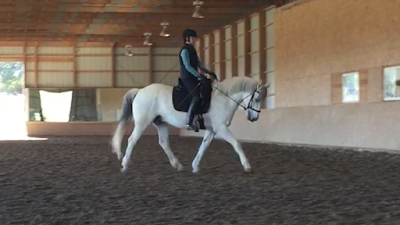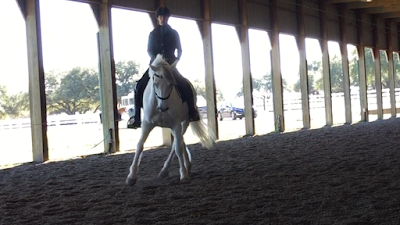The second day of the Alfredo clinic, we worked primarily on more shoulder in and renvers. But what stuck most in my mind about this lesson was what Alfredo had to say about warm-up.
At home, we usually take a short trail ride to the field where we do most of our work, so we have a 10+ minute walk warm-up. Then I do some trot and canter on a long rein, take a bit of a breather, and then consider us ready to get down to business.
Alfredo's suggestion was much different. Instead of doing long stretches at any one gait, he had us do perhaps a circle or a half circle of one thing, then a circle of walk, then pick the reins back up, do something else, walk, etc. Essentially it was a lot of very sort bits of bending and flexing, working lower and then asking for a few steps of collection, working lower, back to walk - just lots of gentle transitions, gentle flexing, and gentle laterals. I posted the trot the whole time to let his back warm up (I normally do a lot of posting so that wasn't new).
Longer rein at the beginning of the ride
Asking for him to come a bit more together
As the session went on, we asked for more sustained stretches of collection, more angle in the laterals, more bend, and a faster response off the leg. Again, Alfredo's method is very short stretches of good work, followed immediately by a walk/reward break when
the horse does the exercise well the rider does the exercise correctly.
Flexion left with a bit more collection
Really asking that hind leg to come through
The trot near the end of the ride
I can certainly see the benefits of shorter chunks of work, especially with an older horse, but I do worry a little about building more fitness and also the horse expecting that he only has to work for short periods of time (ahem).
We did have one fantastically excellent spook when a pitchfork that was leaning against the side of the arena slid down the wall and onto the ground...
Thank goodness for saddles with ginormous thigh blocks!
Another super interesting thing Alfredo said was about getting better scores on a movement. If your movement starts well, then the judge is likely to have in their heads a 6.5 or a 7. If you ride half of it well and then it falls apart, you might end up with a 6.5 or a 6, depending on where you started. BUT, if your movement starts off really badly, the judge might have in their heads a 5, and even if the second half of the movement is great, you're unlikely to score more than a 5.5 or a 6. So it's really important to set up the movement well and make that good first impression, even if it falls apart later. Easier said than done, of course!
Meh
Better
THAT's what you want to come out of the gate with!


















